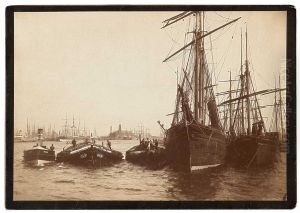Georg Koppmann Paintings
Georg Koppmann was a prominent German photographer in the 19th century, known for his significant contributions to architectural and cityscape photography. Born on October 21, 1842, in Hörde, which is now part of Dortmund, Koppmann grew up during a period of rapid industrialization and urban development in Germany.
Before embarking on his career as a photographer, Koppmann studied at the Polytechnic School in Hannover. He then worked as a lithographer, which gave him a strong foundation in the graphic arts. It wasn't long before he developed an interest in the emerging field of photography.
In the 1860s, Koppmann moved to Hamburg, where he established himself as a professional photographer. He became especially well-known for his comprehensive documentation of Hamburg before and after the great fire of 1842, providing a valuable historical record of the city's architecture and urban life. His work was not merely documentary, as he paid great attention to the aesthetic and compositional aspects of his photographs, which has earned him recognition among art historians and collectors.
Koppmann's photographs were taken with a large-format camera, which allowed him to capture the fine details of his subjects. He was particularly adept at using the natural light to enhance the texture and depth of his images. His photography of Hamburg includes panoramic views of the harbor, as well as more intimate street scenes that convey the character and atmosphere of the city during the second half of the 19th century.
In addition to his work in Hamburg, Koppmann also traveled to other parts of Germany and Europe to photograph notable buildings and landscapes. His contributions to the field of photography were acknowledged during his lifetime, and he was commissioned by both public and private clients who sought to preserve a visual record of their properties and projects.
Throughout his life, Koppmann remained deeply engaged with developments in photography, and he was a member of various photographic societies. His works were exhibited in his lifetime and continue to be shown posthumously, reflecting the lasting value of his photographic legacy.
Georg Koppmann passed away on December 27, 1909, in Hamburg. His extensive body of work has continued to be studied and appreciated for its historical significance and artistic merit. Koppmann's photographs are not only important historical documents but also testify to the power of photography as a medium that can capture and preserve the fleeting moments of urban transformation.
